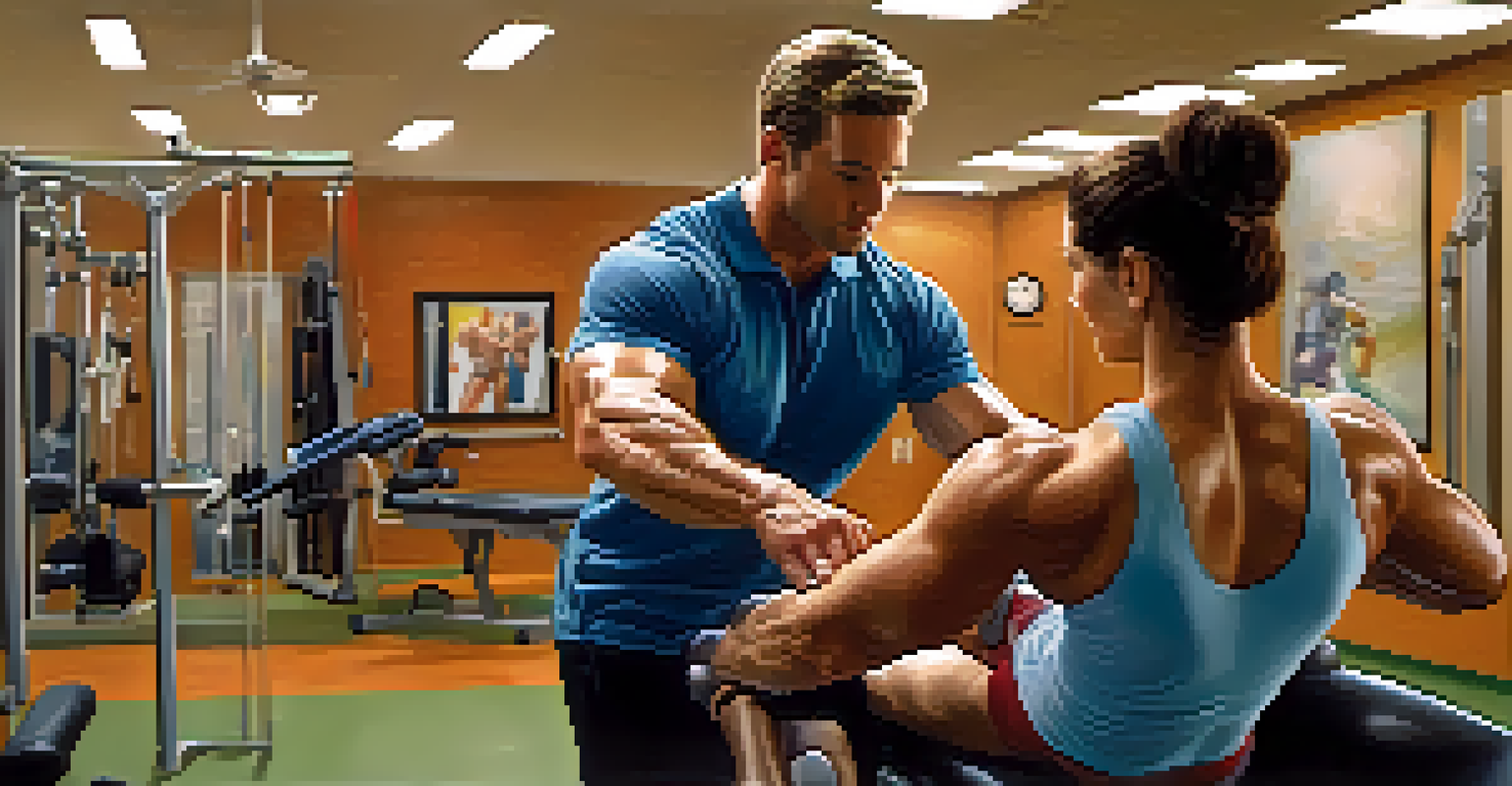Rehabilitation Techniques for Muscle Strains in Bodybuilders

Understanding Muscle Strains: Causes and Symptoms
Muscle strains often occur when a muscle is stretched beyond its limits, which can happen during intense workouts or improper lifting techniques. For bodybuilders, this can lead to frustrating downtime, but understanding the causes is the first step toward recovery. Common symptoms include sharp pain, swelling, and limited mobility in the affected area, making it crucial to recognize these signs early.
Strength does not come from physical capacity. It comes from an indomitable will.
In addition to physical strain, factors like fatigue, poor warm-up routines, and inadequate recovery time can increase the risk of injuries. Bodybuilders often push their limits, which can sometimes lead to neglecting proper techniques. Recognizing these risks can help in taking preventive measures before they lead to a muscle strain.
Ultimately, knowing what causes muscle strains allows bodybuilders to adjust their training regimens to minimize injury risk. This awareness can also lead to more effective rehabilitation strategies when injuries do occur, ensuring a smoother return to training.
Initial Response: R.I.C.E Method for Muscle Strains
When a muscle strain occurs, the R.I.C.E method—Rest, Ice, Compression, and Elevation—provides immediate relief and aids recovery. Resting the affected muscle helps prevent further injury and allows healing to begin. Applying ice reduces swelling and numbs the pain, while compression using bandages can help support the injured area.

Elevation is often overlooked but plays a crucial role in minimizing swelling. By keeping the injured muscle elevated above heart level, you can facilitate better blood flow and reduce inflammation. This initial care is essential in the early stages of a muscle strain, laying the groundwork for effective rehabilitation.
Recognize Muscle Strain Symptoms
Identifying symptoms like sharp pain and swelling early can aid in effective recovery from muscle strains.
Implementing the R.I.C.E method immediately following an injury can significantly shorten recovery time. Bodybuilders can then transition to more active rehabilitation techniques as the muscle begins to heal, promoting a return to their training routine.
Assessing the Severity of the Muscle Strain
Not all muscle strains are created equal; understanding the severity is vital for effective rehabilitation. Strains are typically classified into three grades: Grade I (mild), Grade II (moderate), and Grade III (severe). Grade I strains may involve minor discomfort, while Grade III can lead to complete tears requiring medical attention.
The difference between a successful person and others is not a lack of strength, not a lack of knowledge, but rather a lack in will.
Bodybuilders should assess their symptoms and consider seeking professional evaluation if pain persists. A healthcare professional can provide an accurate diagnosis and recommend appropriate rehabilitation strategies tailored to the injury's severity. This assessment can prevent further complications and ensure a targeted recovery plan.
Knowing the strain's severity helps bodybuilders set realistic recovery goals. It also informs the choice of rehabilitation techniques, ensuring that the approach aligns with the specific needs of the injury, ultimately leading to a safer return to training.
Gentle Stretching: Promoting Flexibility and Healing
Once the initial pain and swelling have subsided, gentle stretching can play a crucial role in rehabilitation. This helps restore flexibility and range of motion, which can be compromised after a muscle strain. Starting with light stretches allows the body to reintroduce movement without overexerting the injured muscle.
Incorporating dynamic stretching into the warm-up routine can also prepare the muscles for more intense workouts. This gradual approach helps bodybuilders ease back into their training regime while minimizing the risk of re-injury. Remember, stretching should never cause pain; if it does, it’s a sign to ease off and consult a professional.
R.I.C.E Method for Immediate Relief
Applying the R.I.C.E method—Rest, Ice, Compression, and Elevation—can significantly reduce recovery time after a muscle strain.
The goal is to balance recovery with maintaining flexibility, ensuring that muscles are ready for action when the bodybuilder returns to their workouts. Regular stretching not only aids healing but contributes to overall performance and injury prevention in the long run.
Strengthening Exercises: Rebuilding Muscle Stability
After the initial stages of recovery, strengthening exercises become essential in rehabilitation. These exercises help rebuild muscle stability and prevent future injuries by targeting the muscles surrounding the injured area. For bodybuilders, focusing on both the injured muscle and supporting muscles is key to regaining strength.
Start with low-resistance exercises and gradually increase intensity as the muscle heals. Techniques such as isometric exercises, which involve contracting the muscle without moving the joint, can be particularly effective in early rehabilitation stages. This approach allows for strength building without risking further strain.
As strength improves, bodybuilders can progressively add more complex movements to their routine. This gradual increase helps ensure that the muscles are ready for the demands of bodybuilding, ultimately leading to a more resilient physique.
Incorporating Professional Guidance: Physical Therapy
While self-directed rehabilitation is valuable, seeking professional guidance can significantly enhance recovery. A physical therapist can assess the injury, provide tailored exercises, and monitor progress. Their expertise ensures that bodybuilders are following safe and effective rehabilitation protocols.
Physical therapy often includes a mix of manual therapy, specific exercises, and modalities like ultrasound or electrical stimulation. These techniques aim to reduce pain, improve mobility, and expedite healing. Additionally, therapists can educate bodybuilders on proper techniques to avoid future injuries.
Professional Guidance Supports Recovery
Incorporating physical therapy into rehabilitation enhances healing and provides valuable knowledge for injury prevention.
Incorporating professional support into the rehabilitation process not only helps in recovery but also empowers bodybuilders with knowledge for injury prevention. This collaborative approach can lead to a more successful return to training and improved performance in the long run.
Gradual Return to Training: Listening to Your Body
Returning to training after a muscle strain should be a gradual process that prioritizes listening to your body. Many bodybuilders are eager to jump back into their routine, but rushing can lead to re-injury. It's essential to ease back into workouts and only increase intensity when comfortable.
Consider modifying exercises and reducing weights initially to allow the muscle to adapt. Incorporating more rest days and focusing on recovery techniques during this phase is also crucial. This patient approach not only benefits the injured muscle but enhances overall performance as well.

Ultimately, understanding your body’s signals is vital in this phase. Bodybuilders who take the time to recover properly will find themselves stronger and more resilient, ready to tackle their training goals with renewed energy.